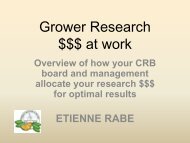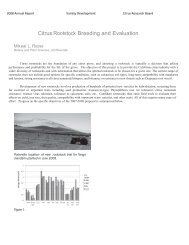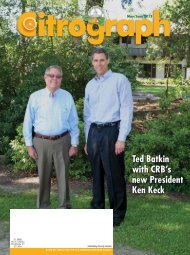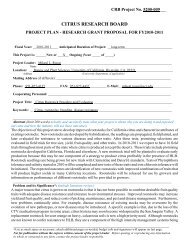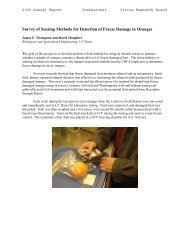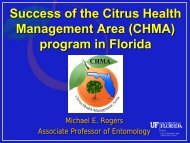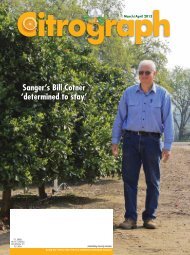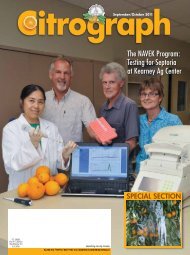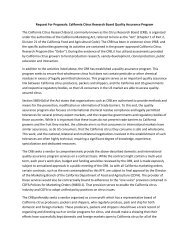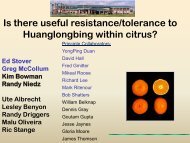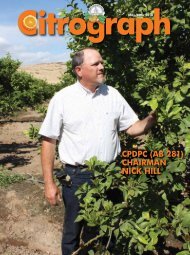Download This Issue - Citrus Research Board
Download This Issue - Citrus Research Board
Download This Issue - Citrus Research Board
Create successful ePaper yourself
Turn your PDF publications into a flip-book with our unique Google optimized e-Paper software.
Charlie and his wife, Irene, then<br />
headed west to the University of California<br />
Davis, where he earned his Ph.D.<br />
in plant physiology in 1958. Interestingly,<br />
in 1957 Charlie had already joined<br />
the University of California Riverside<br />
(UCR) as a junior plant physiologist.<br />
Surprisingly, years later Charlie admitted,<br />
“I was never interested in doing<br />
research on citrus.”<br />
While pursuing his B.S. and M.S.<br />
degrees, he had become interested in<br />
herbicide physiology. <strong>This</strong> was the basis<br />
for his decision to pursue a Ph.D. at UC<br />
Davis, where he could study with Professor<br />
Alden Crafts, the giant in herbicide<br />
physiology at that time.<br />
It was an inquiry from UCR regarding<br />
a position they had open in<br />
plant growth regulation in citrus that<br />
brought Dr. Coggins to Riverside.<br />
Charlie was reluctant to accept the position<br />
because he considered the PGR<br />
researchers of the day “a flaky bunch<br />
of people.”<br />
Fortunately for the industry, he accepted<br />
UCR’s offer, later recalling, “I<br />
was asked to make better use of plant<br />
growth regulators on citrus. That was<br />
all.” Charlie certainly accomplished<br />
that and then some!<br />
At the time that Dr. Coggins was<br />
initiating his research program on citrus<br />
at UCR, ‘Washington’ navel and<br />
‘Valencia’ sweet oranges dominated<br />
California citrus production. California’s<br />
picture-perfect fruit were in great<br />
demand for their excellent eating quality<br />
by consumers throughout the United<br />
States. However, fruit were only available<br />
two times per year, as first navels<br />
and then ‘Valencias’ reached maturity.<br />
Harvesting, packing and marketing<br />
each cultivar within the narrow period<br />
of time that was defined by achieving<br />
acceptable eating quality at the beginning<br />
of the season and avoiding unacceptable<br />
losses due to excessive drop of<br />
senescent fruit at the end of the season<br />
had its problems.<br />
First, there were the negative consequences<br />
on fruit value and grower income<br />
associated with flooding the consumer<br />
market with product due to the<br />
need to get the fruit off the trees. <strong>This</strong><br />
pressure grew steadily worse as navel<br />
orange acreage increased.<br />
Second, for three months out of<br />
each year, packinghouses were without<br />
fruit and their labor force without employment.<br />
The industry was basically<br />
shut down for that period, impacting<br />
suppliers, the large migrant labor force<br />
supporting the industry which annually<br />
packed up and moved, and the local<br />
“mom and pop” shops, gas stations, and<br />
restaurants frequented by labor families.<br />
Moreover, a very valuable asset<br />
– the packinghouse – was sitting idle<br />
three months of the year!<br />
Appreciating the impact of gibbing<br />
Gibbing changed everything! Fruit<br />
could now be stored on the tree well<br />
past the “normal” maturity window<br />
for the cultivar, making it possible to<br />
harvest, pack and market navels and<br />
‘Valencias’ over longer periods, supplying<br />
consumers with fresh oranges<br />
12 months of the year. Moreover, GA 3<br />
-<br />
treated fruit were of superior quality<br />
(i.e., the incidence of rind staining, water<br />
spot, puff and sticky rind were all<br />
reduced by GA 3<br />
).<br />
The financial benefit of year-round<br />
marketing of sweet oranges is so huge<br />
it is difficult to calculate with accuracy.<br />
In contrast, the fundamental changes<br />
to the California citrus industry from<br />
having a year-round supply of fruit are<br />
easy to enumerate because they are as<br />
Dr. Coggins remains the perfect example of those<br />
few rare scientists who have made important<br />
basic research discoveries of phenomenal<br />
practical benefit to crop production.<br />
Photo courtesy of UC Riverside.<br />
November/December 2012 Citrograph 17



